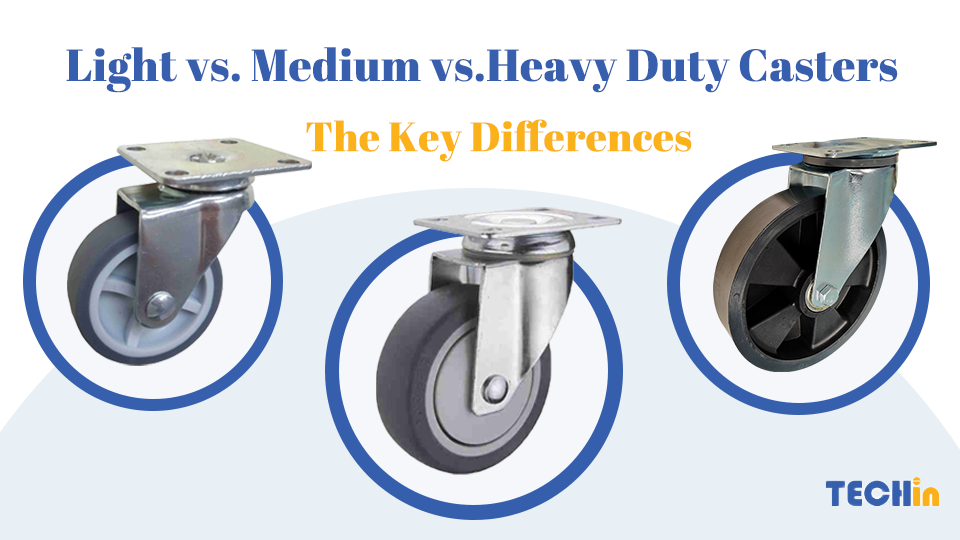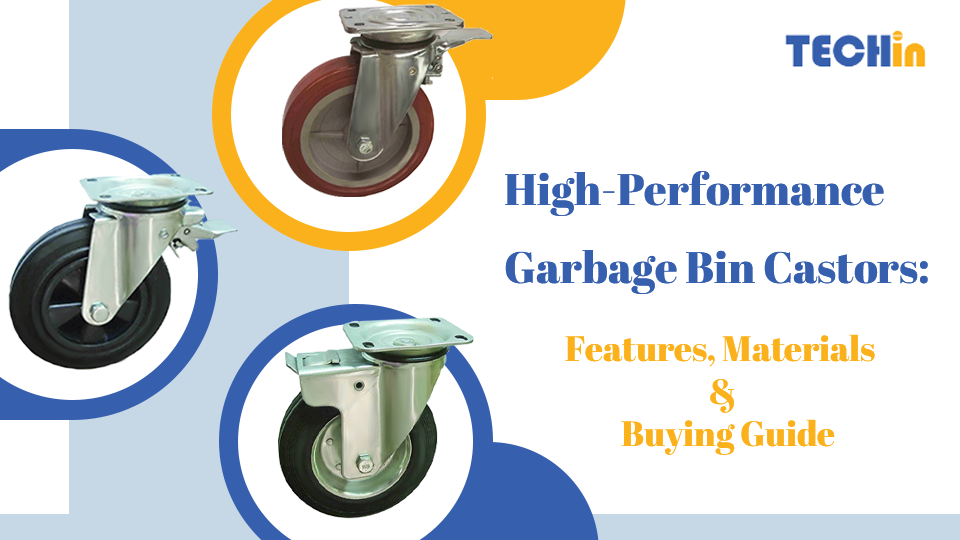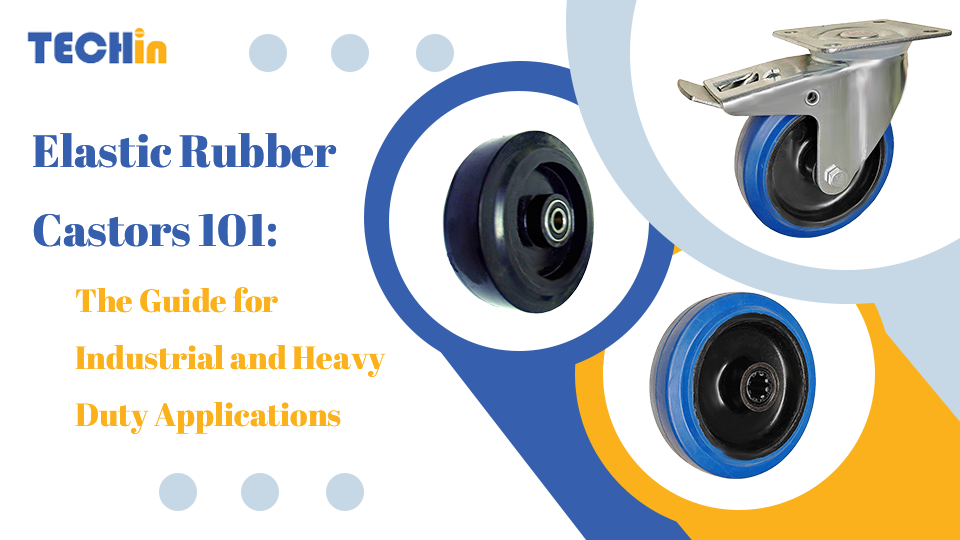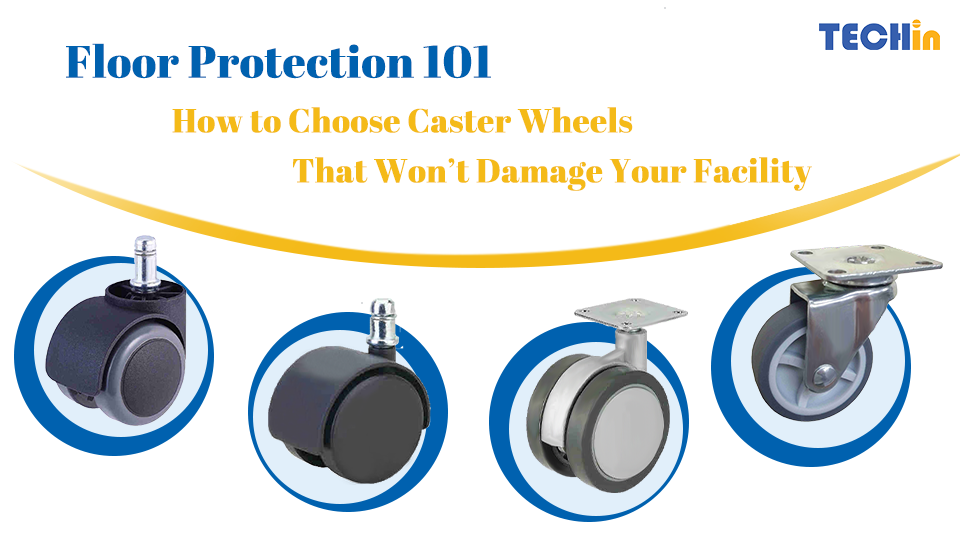Choosing the right caster wheel is a critical decision that impacts efficiency, safety, and your budget. An incorrect choice can lead to downtime, floor damage, or unnecessary costs. A common question we help customers with is understanding the difference between light, medium, and heavy-duty casters. This guide explains each type, their best uses, and how to select the right one for your project.
In short: Light duty casters support 10–140 kg (22–310 lbs) and are suited for furniture and office equipment. Medium duty casters handle 100–420 kg (220–925 lbs), making them ideal for warehouses and factories. Heavy duty casters carry 350–1000+ kg (770–2200+ lbs) and are engineered for machinery and heavy platforms. The key differences are found in their load capacity, holder construction, wheel materials, and bearings.
Now, let’s explore each caster type in more detail. We’ll follow up with a comparison table and practical buying tips to help you make an informed choice.
What is Light Duty Caster Wheel?
Light-duty casters are engineered for lighter loads, generally between 10–140 kg (22–310 lbs). They are most commonly found in applications such as:
- Furniture (chairs, sofas, beds)
- Office equipment (desks, printers)
- Medical and school equipment
- Supermarket carts
Construction Features:
- Holders: Made from 2–4 mm stamped steel, typically electroplated for corrosion resistance.
- Bearings: Utilize plain or simplex ball bearings for simple mobility.
- Design: Lightweight, quiet, and easy to maneuver.
👉 Perfect for smooth floors and environments where mobility and low noise are the main priorities.
What is Medium Duty Caster Wheel?
Medium-duty casters are the versatile workhorse for most industrial and logistics operations, covering the 100–420 kg (220–925 lbs) range. Common uses include:
- Factories and assembly lines
- Warehouses
- Industrial trolleys and carts
Construction Features:
- Holders: Built with thicker 5–6 mm stamped or hot-forged steel and welded for greater strength.
- Bearings: Feature duplex ball bearings, ensuring smoother rolling under heavier loads.
- Wheel Materials: Use durable elastic rubber, polyurethane (PU), or polyamide (PA) on steel or aluminum rims.
👉 This casters offers an excellent balance of strength and mobility, designed to perform reliably in busy workplaces with frequent cargo handling.
What is Heavy Duty Caster Wheel?
Heavy-duty casters are built to handle 350–1000+ kg (770–2200+ lbs) per wheel. They are engineered for extreme conditions and heavy industrial use, including:
- Textile mills
- Machinery plants
- Motor works
- Transport platforms for oversized loads
Construction Features:
- Holders: Fabricated from very thick 8–12 mm cut and welded steel for maximum durability.
- Bearings: Use heavy-duty ball or flat ball bearings for smooth, flexible rotation under significant stress.
- Wheel Materials: Made from robust materials like solid polyamide (PA), cast iron, or polyurethane (PU) bonded to metal cores.
👉 These casters prioritize durability, impact resistance, and long-term reliability in the most demanding environments.
What Are the Differences Between Light, Medium, and Heavy Duty Caster Wheels?
While all casters provide mobility, the primary differences lie in their load capacity, the environments they are designed for, and the durability of their construction. Light-duty casters are best for smooth floors and lighter equipment. Medium-duty casters provide a solid balance of strength and mobility for industrial settings. Heavy-duty casters, in contrast, are engineered for extreme loads and tough conditions where reliability is paramount.
Here’s a side-by-side comparison:
| Feature | Light Duty | Medium Duty | Heavy Duty |
|---|---|---|---|
| Load Capacity | 10–140 kg (22–310 lbs) | 100–420 kg (220–925 lbs) | 350–1000+ kg (770–2200+ lbs) |
| Applications | Furniture, office, hospital, supermarket carts | Warehouses, factories, industrial carts | Machinery plants, textile mills, heavy platforms |
| Holder Thickness | 2–4 mm (thin steel) | 5–6 mm (thicker steel, welded) | 8–12 mm (very thick cut & welded steel) |
| Bearing Type | Plain, simplex ball | Duplex ball | Heavy-duty ball, flat ball |
| Wheel Materials | PP, PA, TPR, PU | Elastic rubber, PU, PA, metal rim | Cast iron, PU on metal core, solid PA |
How to Choose Between Light, Medium, and Heavy Duty Casters?
When selecting your caster wheels, it’s important to consider these factors:
- Load Capacity: Always match the caster’s strength to your maximum load requirements.
- Floor Conditions: Smooth floors are fine for light duty, while rougher industrial surfaces demand medium or heavy duty wheels.
- Mobility Needs: More advanced bearings provide smoother rolling, especially under heavy weight.
- Durability vs. Cost: Heavy duty casters offer greater longevity but come at a higher initial price.
- Application Frequency: For daily industrial use, it’s best to avoid light duty casters to ensure reliability.
👉 A good rule of thumb: calculate your maximum load, divide it by the number of wheels, and then choose a caster category that comfortably exceeds that per-wheel capacity.
What Applications Are Medium Duty Casters Best For?
Medium duty casters are the preferred choice for factories, logistics, and storage environments where loads are moderate but handled frequently. Examples include:
- Warehouse carts
- Order-picking trolleys
- Industrial tool carts
- Light machinery platforms
They are the ideal solution when you need proven durability without the scale of a heavy-duty caster.
What Are Heavy Duty Casters Used For?
Heavy duty casters are indispensable in industries where load security and impact resistance are critical. Typical uses include:
- Moving large machinery in plants
- Transporting oversized goods in textile or automotive factories
- Heavy-duty platforms in construction or shipbuilding
They are designed to withstand constant use, high stress, and uneven flooring with exceptional reliability.
Summary
Caster wheels may appear simple, but choosing the correct type—light, medium, or heavy-duty—is fundamental to your project’s safety, cost, and performance. By evaluating the load, floor type, and frequency of use, you can make a smarter, more effective decision.










